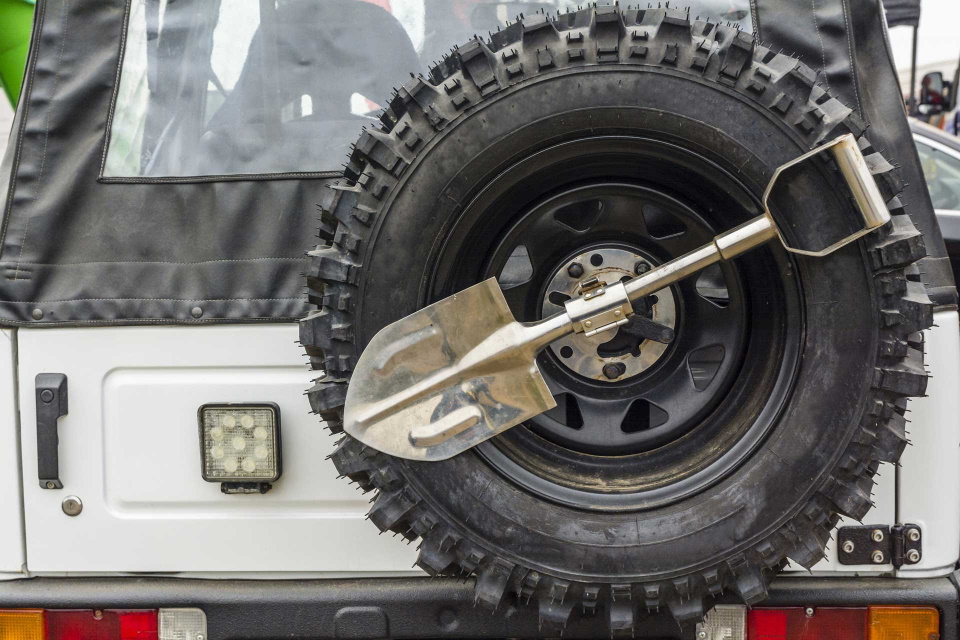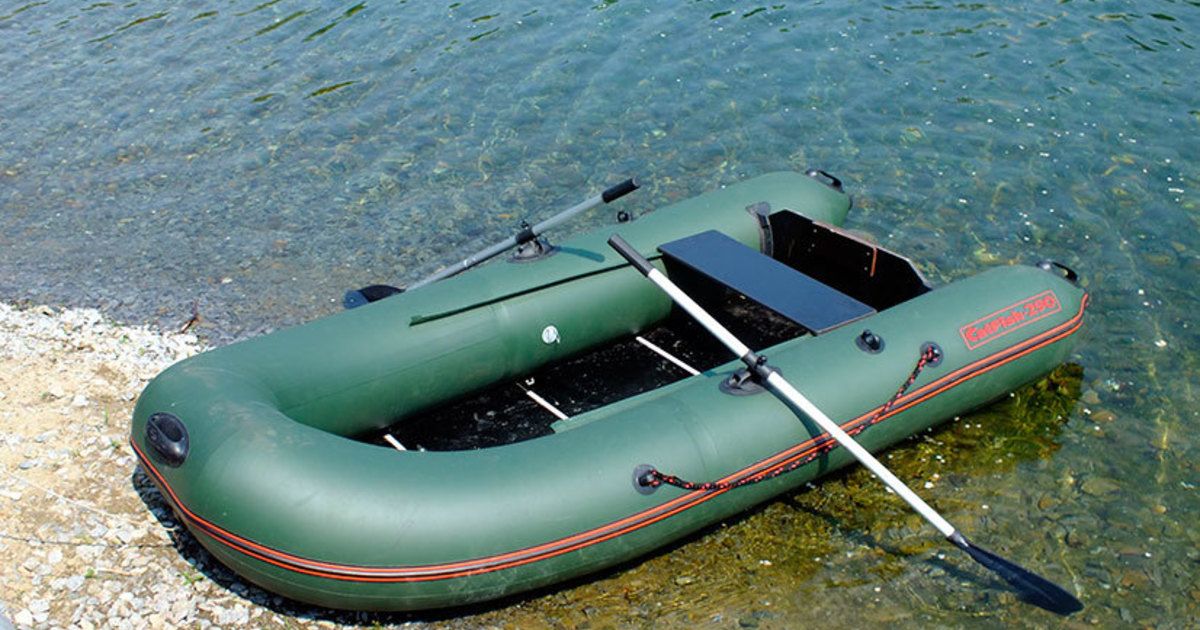Rating of the best ice axes for mountaineering for 2022
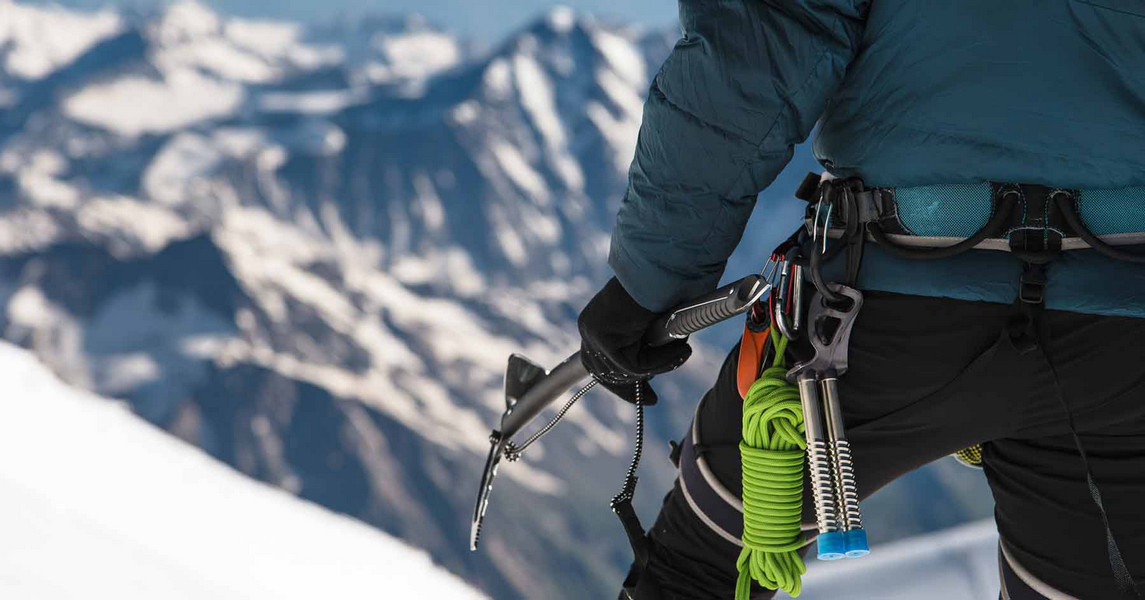
An ice ax (aka ice bail) is the most important part of any climbing equipment for mountain tourism. It is designed to create additional reference points on ice, loose or snowy slopes. In addition, it can be used as a safety tool.
Currently, there are many variations of this equipment on the market, so its selection should be carried out according to individual rules for each person. In general, icebails can differ both in the shape and material of the shaft itself, and in the shape and material of their working part - the beak, with the help of which the hold is carried out at a certain point.
Today, ice tools are becoming more and more popular, as a direct result of the growing popularity of dry tooling/ice climbing.It differs from the standard icebile in a more curved shape and an aggressively bent beak. And its main difference is that it is usually used in pairs - one device in each hand.
By itself, the ice ax should be light, reliable and easy to use - however, like any other element of mountaineering equipment. High-quality inventory will provide a high level of necessary security and will allow you to successfully complete the tourist route. Moreover, when performing the function of self-insurance, the life of a climber will directly depend on it.
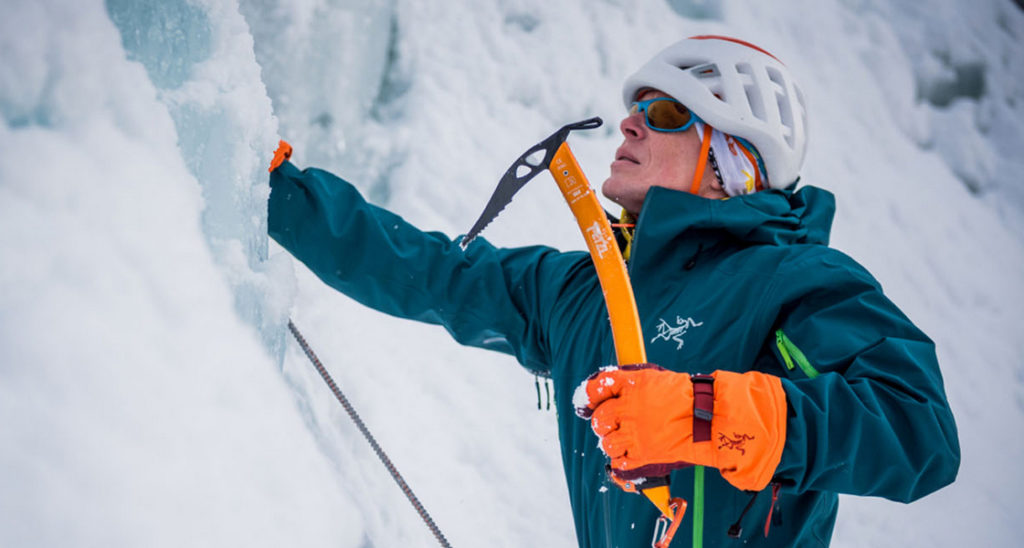
Content
- 1 Ice tool/ice ax design
- 2 Production technology and materials used
- 3 Ice ax and ice tool - differences
- 4 Competent preparation of the ice-bile
- 5 Basic rules for choosing ice ax equipment
- 6 Rating of the best ice axes for mountaineering for 2022
- 7 Finally
Ice tool/ice ax design
The main elements of the structure of the described inventory are:
- Beak (aka pickaxe);
- Head (top), equipped with a hole for a carabiner;
- Spatula (adze);
- Leash (lanyard);
- Limiter for a leash;
- Spike (bayonet), equipped with a hole for a carabiner.
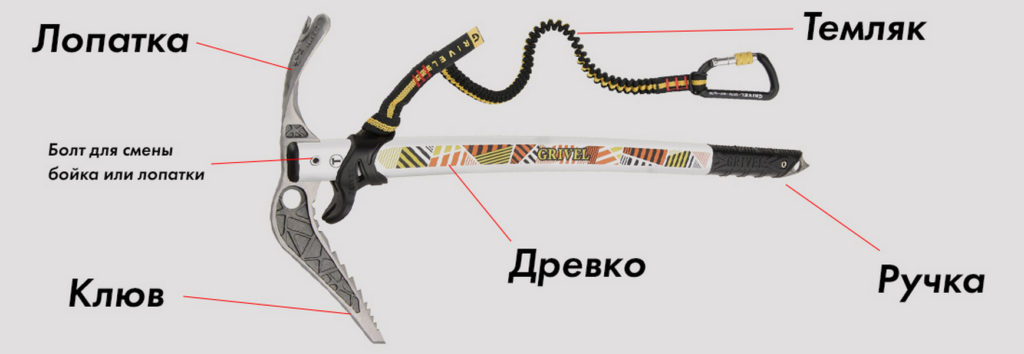
Further, each element should be considered in more detail:
head (top) structurally includes a beak (pick), blades (adze), but the holes for fastening are usually made separately (made of steel alloy). In special tools that are designed for climbing steep ice or for difficult ice-mountain ascents, the adze is used in rare cases, more often it is replaced with a striker. To replace, you just need to unscrew the screws and remove the adze. Thus, in addition, you can save a lot of sports equipment.
Beak (pick) is the pointed end of an ice bail, which is used for a fly hook on ice or stone. Also, with the help of this working part, it is possible to leave notches on trees for orientation on the terrain. The beak can be characterized by the curvature of its angle and clearance. The angle can be determined relative to the main axis of the metal head (top). This value varies between 65-70 degrees (which is the nominal value for most ice axes). But for ice tools, a sharper angle is provided - 55-60 degrees.
ground clearance called the beveled edge of the beak, which can be negative (negative) or positive (positive). This indicator is determined by comparing the sharpened angle of the beak tip in relation to the handle.
The clearance scheme in modern mountaineering is not given much importance for two reasons:
- Most athletes choose positive (positive) clearance;
- Practice shows that both positive and negative clearances are equally great for securing an ice ax in ice or a mountain surface.
IMPORTANT: Positive clearance, with its precise moment during the hooking process, can provide slightly better efficiency when climbing a glacier. At the same time, some types of sports equipment with negative clearance are better suited for climbing during mountain snowstorms. It is always worth remembering that the clearance can be changed independently, depending on the conditions of the upcoming tourist route - you just need to choose the right angle and sharpness of the edge and grind it with high quality.
Spatula (adze) - this is a wide end in the form of a small spatula, used to carve steps for a step or various niches in the ice. It can also serve as a platform through which it is convenient to grip the ice ax itself. Using a similar grip, ascent can be carried out using the so-called anchor technique.
carabiner hole - it is located in the head of the sports equipment, as well as in the bayonet. As a rule, it is used to attach an instrument to a leash. In addition, it can be used for attaching to a carabiner.
Shaft (handle) - usually made of carbon fiber, steel or aluminum. Any of the listed variations has its advantages in terms of weight and reliability. Weighted handles are durable, however, carbon fiber samples can also boast of this, and their weight will be much less (but the cost is several times more expensive). A straight pole is better suited for personal belay, canopy or anchor climbing. In addition, it is better suited directly for mountaineering. Curved shaft samples are an arc and, from an anatomical point of view, are better suited for swinging and cutting ice.They are preferable to use on technically difficult ascents on a continuous glacier. There are also types of handles, which are partially or along the entire length covered with rubber pads, which increases the rigidity of the grip of the tool with the athlete's hand.
NOTE: A firm grip on the pole can also be achieved by using special gloves or by wrapping the pole with special sports tape.
Spike (bayonet) - This is a sharp steel tip of the ice bail, which, upon impact, allows deep penetration into the surface of ice or rock. As a standard, it acts as a stabilizer, maintaining the balance of the tourist's body when moving on ice or snow, and can also be used as a support. Some models of ice axes do not have a spike, which is done in order to reduce the weight of the equipment. At the same time, its absence increases the safety of the user when the equipment is used in the opposite, pulling direction (in other words, when moving up and down, like a lever on a stone).
IMPORTANT! With frequent use of the spike, it can become dull over time. Thus, its regular sharpening is the key to a safe ascent.
Leash (lanyard) – Provides additional security for the ice-bile. By attaching it to the human body, it does not allow it to be dropped from a height.
Production technology and materials used
Beak
For this working part, titanium or steel is used in production. The latter material is used more often due to its cheapness, however, titanium is stronger and harder than steel, but its cost is much more expensive. The manufacturing process itself is hot forging, or stamping, or laser cutting. Professionals prefer forged picks.It is this method that allows you to harden steel, make the pick lighter and thinner, while not losing a significant amount of strength. It is worth noting that forged picks are the most expensive and time-consuming to manufacture. In second place in terms of quality is the method of laser cutting. And finally, the most budgetary models are "stamping".
According to its shape, a pickaxe can be of three types:
- Straight - this type is now extremely rare, this type differs from others only in that it interacts a little better with the ice surface (cutting occurs quite reliably).
- With a positive bend - this type can be found on almost any icebale that has a straight handle. A positively curved pick will allow you to stop faster on a fall, but it will be more difficult to pull it out of the ice. Moreover, he is the worst cut into old and hard ice.
- With a negative bend - this form is installed on all ice tools and the vast majority of icebails with a curved handle. The negative camber will allow you to better cut into the ice surface, it is pulled out easily and naturally, but does not work well in the process of stopping during a fall.
Operating life
As such, this indicator is difficult to determine and even to bring it to average values is difficult. Durability will depend on the conditions of its use. It is worth remembering that the use of an ice ax should be stopped immediately upon detection of the first malfunction (rust, non-standard vibration, deformation during ice cutting). However, if you use the projectile correctly, its life can be very long. Thus, it is important to avoid overloading the sports equipment, dropping it from a great height, jamming and twisting - all this can instantly lead to breakage.In addition, metal corrosion can significantly reduce service life. If the ice ax is used extremely intensively, then its pick must be changed every season. This will allow you not to worry about the formation of microcracks, without noticing which, the tool will break in the hands of the climber at the most inopportune moment.
Ice ax and ice tool - differences
This inventory is the oldest climbing equipment for long ascents. With its help, additional support is provided, self-insurance, in addition, it allows you to stop the fall in the event of a cliff through self-holding. Nominally, the ice ax is intended for movement on a glacier or for climbing snow-covered mountain slopes. If the route passes along a steep slope, then an ice ax is used in conjunction with an ice tool. Professional climbers find this combination very effective.
In turn, ice tools are shorter than ice axes. The latter usually have a length of 65-90 centimeters (depending on the height of the user and the steepness of the route), and the ice tool can vary in length by only 45-55 centimeters. Their shortened length is more conducive to working on steep ice in climbing conditions. If you have to ascend along a very difficult path (for example, a frozen waterfall), then a pair of ice tools are used. In this case, one of the items must be equipped with a shovel, this will be extremely useful when clearing the area for the ice drill.
Competent preparation of the ice-bile
All equipment of this sports equipment will directly depend on the frequency and conditions of its use. For example: for frequent mixed climbing or dry tooling, picks with increased wear resistance are better suited.And for sheer ice climbing, it is better to use sharply sharpened beaks. Professional climbers still advise purchasing several types of picks for different types of climbing at once, and the shaft itself should allow their easy replacement. At the same time, it is preferable to purchase replacement picks from the same brand as the shaft manufacturer. Any inconsistency in construction can lead to an unreliable fastening and, consequently, endanger the climber's life. At the same time, before the start of conquering any route, it is necessary to check the sharpness of sharpening both the beak and the bayonet. It may also happen that you have to overcome large areas of ice in a horizontal plane - in this case, an ice bail with an elongated handle equipped with a spike at the end will become indispensable - it can be perfectly used as a cane.
Basic rules for choosing ice ax equipment
The choice of projectile according to the dimensions of the user
The easiest way is to choose an ice ax along the length - for this you just need to hold it for a while in a relaxed hand. At this time, the bayonet with its tip should barely touch the ground, while the person is standing at full height, and his free hand is lowered along the body. For those people whose height is less than 172 centimeters, a classic mountaineering projectile with a long handle of 65 centimeters is perfect. For tall people, whose height is 188 centimeters and above, it is preferable to use a 75 cm icebile.
At the same time, it should be noted that, for example, two people of the same height may have a different span of the upper limbs and, accordingly, they will have a different so-called “gorilla index”. From this we can conclude that they need different ice axes.The “gorilla index” is very easy to calculate by subtracting the arm span from the height of a person (it is measured from the tip of the middle finger of the left hand to the tip of the middle finger of the right hand). An example is the famous painting by Leonardo da Vinci "The Vitruvian Man", according to the proportions of which, the ideal height of a person is equal to his arm span. However, in nature, such an exact ratio is rare. Therefore, the shorter the hands of a climber-tourist, the longer he will need a tool.
Choice depending on destination
Again, most questions will be about length. Projectiles with a length of less than 60 centimeters are most often used in very technically difficult ice ascents, as well as on extremely steep ice slopes, where there is a sheer vertical icing. Such short ice-bikes are unlikely to be able to do a decent job as a safety lever and are not suitable as their own insurance. From another point of view, devices with a length of more than 79 centimeters are too long for climbing, but will become indispensable assistants when moving along gentle slopes or more or less flat terrain. Their elongated handles are best used in marches organized as a march, in order to make it convenient to climb up using the anchor technique, while checking the strength of the ledges on the mountain or the presence / absence of cracks.
IMPORTANT! It should be remembered that too long ice-bikes can complicate the belay, because the spike-bayonet can enter the snow at a reduced angle, which increases the risk of falling for the climber!
It is necessary to clarify, a clear definition of the golden mean between two or more technical characteristics and factors of the device will allow you to choose a sports equipment with a greater degree of reliability. If you plan to spend a lot of time traveling in gentle terrain (climbing uphill at a slight angle), then a long ice ax will be the best choice. If for the most part you have to travel on steep slopes (mountain hollows and other technical mountaineering), then a short ice ax will definitely be an excellent choice.
Weight selection
The main weight of the described device falls on the shaft-handle. It is made from very strong materials. In the past, it was made from wood (but this is the last century), today aluminum, stainless steel and carbon fiber have become popular. It is also possible to use various metal alloys. A lighter handle may be needed for such types of tourism as ski mountaineering and ice climbing - in these cases, a small mass will allow the tourist to maintain balance, speed and lighten their own overall weight. However, lighter models have a shorter lifespan and do not allow deep penetration into hard ice than their heavier and more powerful counterparts.
With heavy and powerful examples, professionals prefer to walk already on very hard mountain slopes, use them on couloirs of old ice and permafrost, and also work with them on a combination of ice and stone.
CEN-rating and its help in selection
According to the world classification, all types of iceballs are combined into CEN-rating systems. This certification will help a person choose the right sports equipment, relying solely on digital and letter indicators. The abbreviation CEN stands for "Committee of Europe for Standardization" in French.This structure is engaged in the scientific development and approval of standards for technical equipment and equipment. Regarding ice axes, each such projectile must be marked with the Latin letter "T" or "B".
Marking "B" means "main", "initial" or "basic". Such samples are the least durable, but differ in significantly low weight and budget price. Extremely unreliable and not suitable for technically difficult routes. Marking "T" means "technical" - this is more professional equipment, designed for difficult climbs. They are distinguished by high cost, heaviness and an increased degree of strength.
It should be noted that the pick (beak) itself can also be classified according to the CEN rating. Thus, there may be examples of ice axes whose shaft is rated "B" and the beak is "T", and vice versa. It all depends on the choice of the climber himself: someone needs a heavy “T” handle with a “B” rating beak installed in order to increase its flexibility and maneuverability. As a result, choosing the right option based on the CEN marking will not be a problem.
Rating of the best ice axes for mountaineering for 2022
Economy class
3rd place: OCELOT HYPERLIGHT SIMOND
This is a very simple and effective ice ax in the best sense of the word. It is quite light and easy to handle, there is nothing outstanding in it, at the same time it has no pronounced shortcomings either. Worked great on routes of medium difficulty. Decent device for the price.
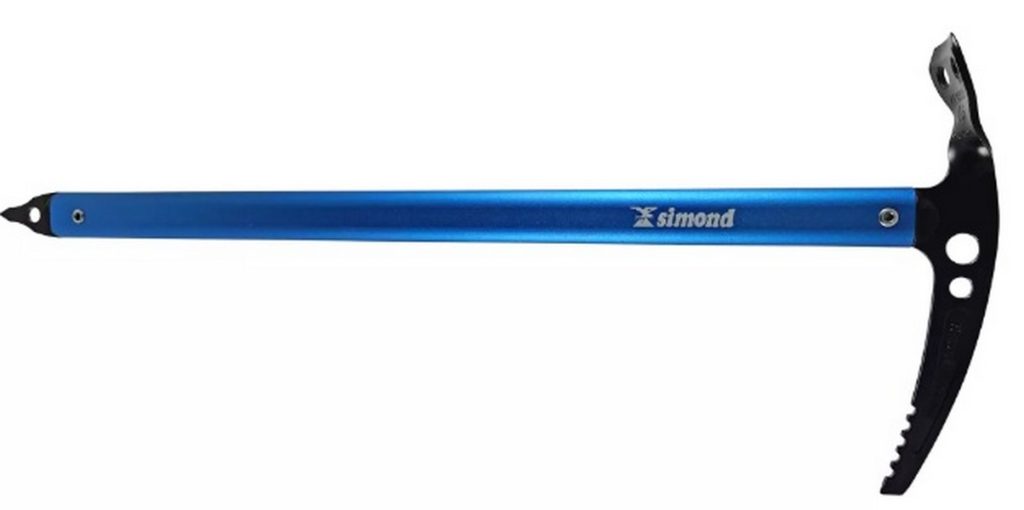
| Name | Index |
|---|---|
| Producing country | India |
| Length variation, see | 60-75 |
| Weight variability, kg | 0,42-0,5 |
| Used materials | Steel, aluminum |
| CEN certification | AT |
| Price, rubles | 2500 |
- Simple and easy to use;
- Lightweight sample;
- Good for beginner climbers.
- Little functionality.
2nd Place: CAMP Camp Neve 57-57
This model has a special streamlined shape, it is perfect for cutting platforms and steps in firn (compacted snow). The steel pick is firmly attached to the straight handle made of aluminum alloy. The set comes with a standard leash by default. The shoulder blade has a curved shape, which makes it easier to grip.

| Name | Index |
|---|---|
| Producing country | Italy |
| Length variation, see | 65 |
| Weight variability, kg | 0.5 |
| Used materials | Aluminium alloy |
| CEN certification | AT |
| Price, rubles | 5400 |
- Good equipment;
- There are holes for a carabiner;
- Availability of additional features.
- Non-durable material.
1st Place: Singing Rock MERLIN
A traditional piece of climbing equipment designed to move on easy snowy slopes and glaciers. The handle is made of high quality aluminum alloy. The spike bayonet is made of alloyed steel, which allows it to be used without problems on packed snow. With the help of a functional blade, it is possible to easily cut steps and platforms in the ice.
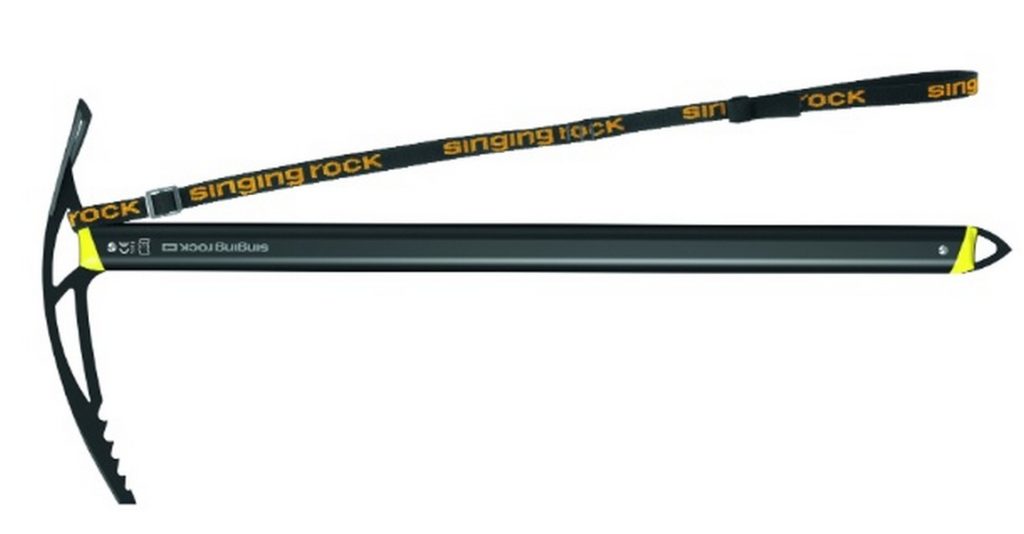
| Name | Index |
|---|---|
| Producing country | Italy |
| Length variation, see | 58-72 |
| Weight variability, kg | 0.48 |
| Used materials | Aluminum alloy, alloy steel |
| CEN certification | AT |
| Price, rubles | 6400 |
- Convenient spatula;
- Effective on firn;
- Spike made of alloy steel.
- High price for simple equipment.
Middle segment
3rd place: Grivel G1 66
Excellent semi-professional model from the world famous Italian manufacturer. It is considered the best model in its segment in terms of price-quality ratio. The shaft is made of high carbon steel, and the beak is made using hot forging technology. Separately, it is mentioned that the beak-pick is able to endure more than one season of grinding and sharpening.
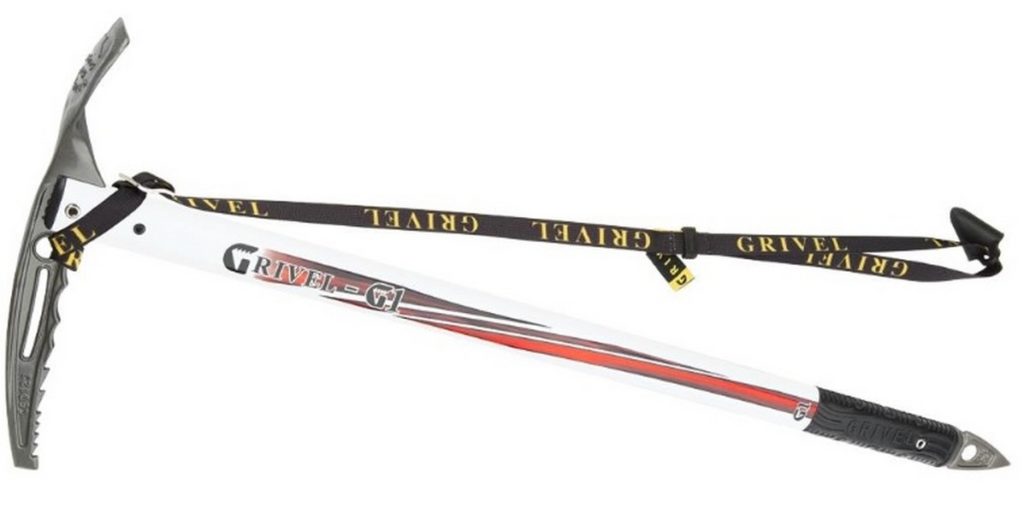
| Name | Index |
|---|---|
| Producing country | Italy |
| Length variation, see | 66 |
| Weight variability, kg | 0.28 |
| Used materials | Carbon steel |
| CEN certification | T |
| Price, rubles | 10100 |
- Rugged housing;
- Extended service life;
- Adequate price.
- Not identified (for its segment).
2nd Place: Petzl Petzl Sum'Tec
This option is an extremely technical device for professional climbers who prefer difficult routes. The model perfectly combines a classic ice ax and individual elements of an ice tool (beak bent down). The guard of the device is versatile: in the lower position it provides a more secure grip, and in the upper position it allows you to stick more freely into the snow.
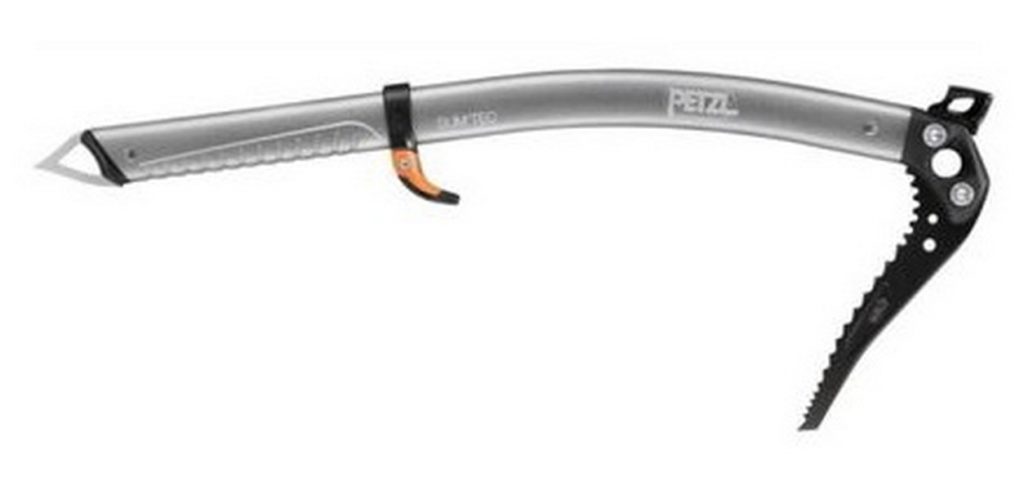
| Name | Index |
|---|---|
| Producing country | France |
| Length variation, see | 55 |
| Weight variability, kg | 0.47 |
| Used materials | Stainless steel |
| CEN certification | V, T |
| Price, rubles | 16100 |
- An innovative technology for adjusting the guard has been applied;
- The combination of an ice ax with an ice tool;
- Convenience of work.
- Completely made of stainless steel (heavy).
1st Place: Air Tech Carbon
The latest model, completely made of composite materials, which ensures its extremely low weight.Suitable for climbing experts who do not want to sacrifice increased strength for the sake of less mass. The top and beak are made of chrome-plated steel using the hot forging method. The shaft itself is made of carbon fiber with sublimated graphics.
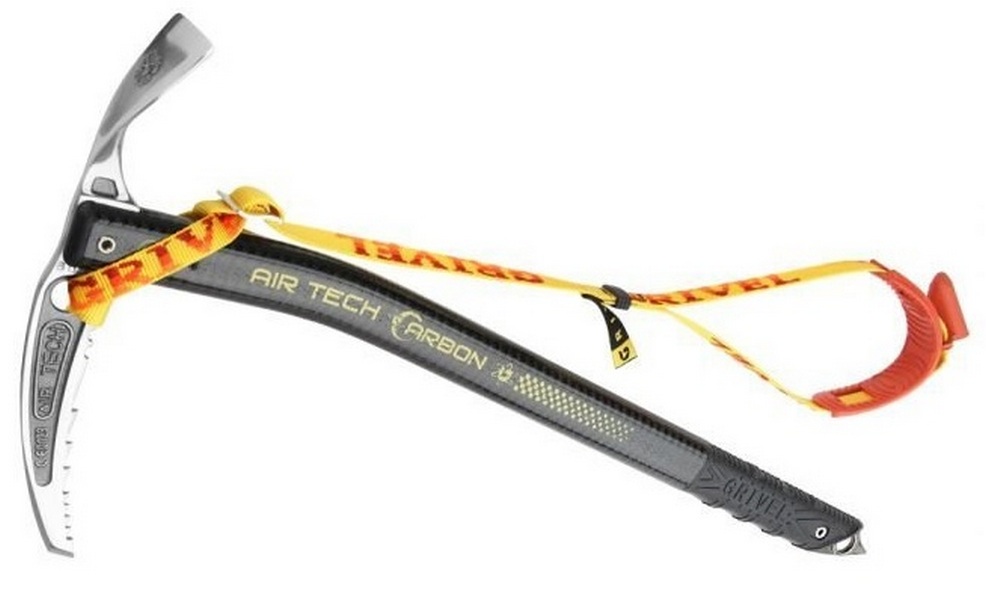
| Name | Index |
|---|---|
| Producing country | Italy |
| Length variation, see | 48-66 |
| Weight variability, kg | 0.3 |
| Used materials | Carbon, chrome steel |
| CEN certification | T |
| Price, rubles | 18500 |
- Ease;
- Applied hot forging method;
- Housing made of composite materials.
- Rarely found in retail.
Professional Models
2nd Place: Black Diamond Fuel Hammer
The considered professional tool is perfect for working on overhanging rocks and long glaciers. The shaft is lightweight, although it is made of aluminum, but using the hydroforming method (this means increased rigidity). The handle is adjustable using the "Fuel" technology, its design is slightly simplified for a quick change of the beak. The set comes with an additional pickaxe "Ice+". The handle is rubberized, double-density pads are installed.
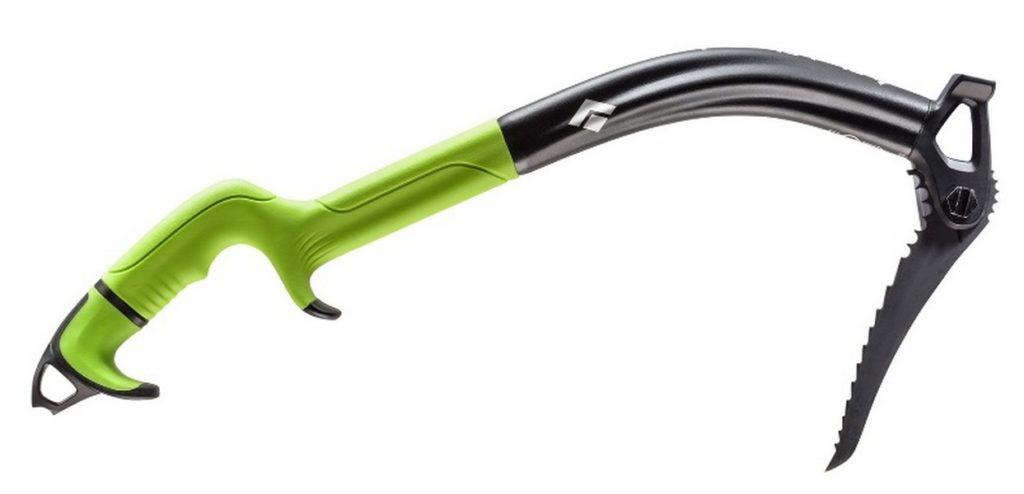
| Name | Index |
|---|---|
| Producing country | USA |
| Length variation, see | 50 |
| Weight variability, kg | 0.65 |
| Used materials | Aluminum |
| CEN certification | T |
| Price, rubles | 22000 |
- Ease of construction;
- The presence in the set of replaceable parts;
- World class quality.
- Only for professionals.
1st place: Elite Climb Raptor
Speaking about this sample, it can rightfully be called an ice tool. It has almost limitless functionality and is anatomically correct. The design simultaneously uses Kevlar (beak) and carbon (handle).The beak is fixed according to the XMS standard - the best fastening in the modern world. At the bottom of the handle there is a hole for a leash, the shaft itself is covered with abrasive paint for perfect grip.
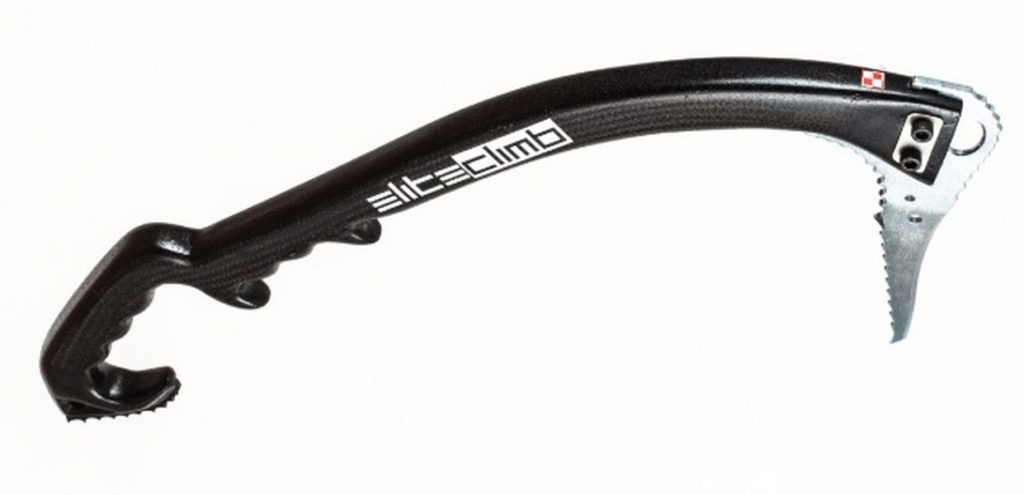
| Name | Index |
|---|---|
| Producing country | Poland |
| Length variation, see | 50 |
| Weight variability, kg | 0.43 |
| Used materials | carbon, kevlar |
| CEN certification | T |
| Price, rubles | 24000 |
- Versatility;
- Innovative technologies are used;
- Decent price.
- Not found.
Finally
Climbing mountains, even at the amateur level, will always require a person to use special equipment. Ice ax - the most common of them. Proper selection of this equipment and knowledge of the basic principles of its use (including construction) will turn a mountain walk into an unforgettable trip.
new entries
Categories
Useful
Popular Articles
-

Top ranking of the best and cheapest scooters up to 50cc in 2022
Views: 131651 -

Rating of the best soundproofing materials for an apartment in 2022
Views: 127690 -

Rating of cheap analogues of expensive medicines for flu and colds for 2022
Views: 124519 -

The best men's sneakers in 2022
Views: 124033 -

The Best Complex Vitamins in 2022
Views: 121940 -

Top ranking of the best smartwatches 2022 - price-quality ratio
Views: 114980 -

The best paint for gray hair - top rating 2022
Views: 113395 -

Ranking of the best wood paints for interior work in 2022
Views: 110318 -

Rating of the best spinning reels in 2022
Views: 105329 -

Ranking of the best sex dolls for men for 2022
Views: 104366 -

Ranking of the best action cameras from China in 2022
Views: 102216 -

The most effective calcium preparations for adults and children in 2022
Views: 102011

